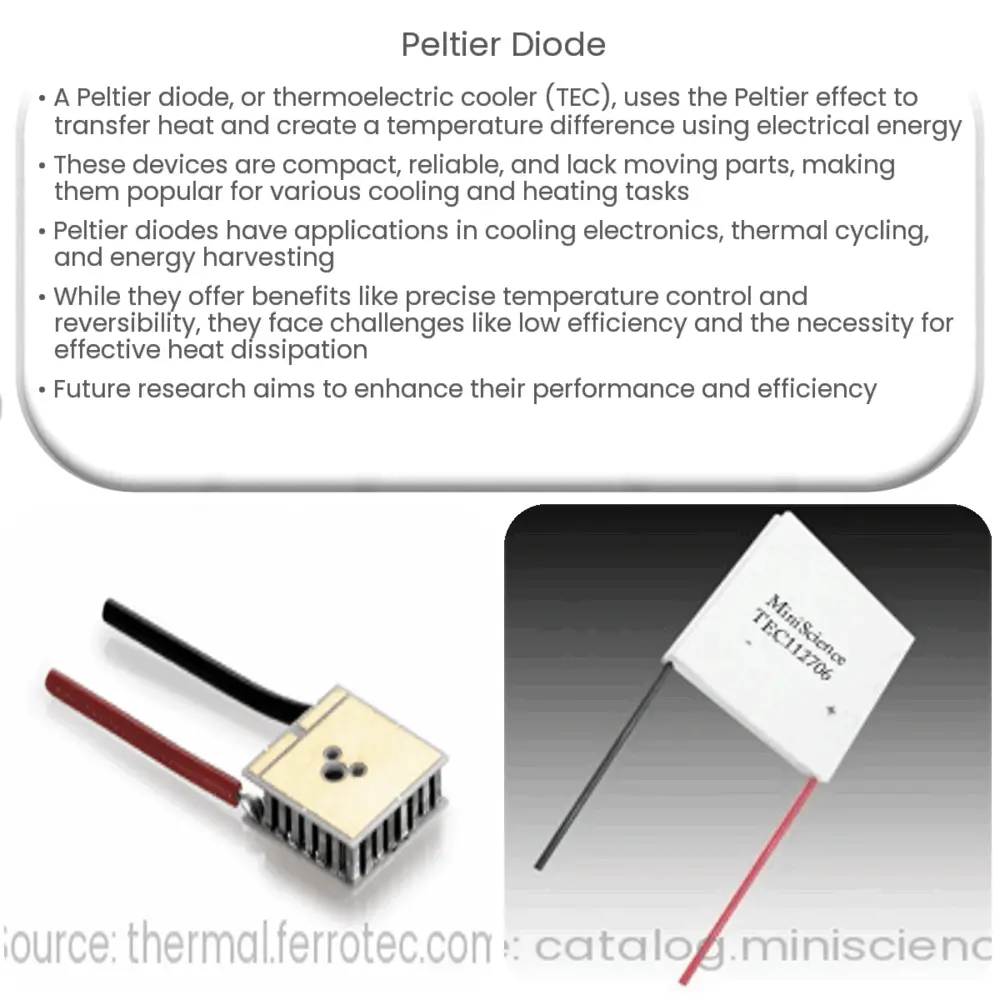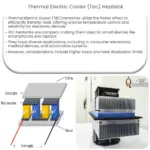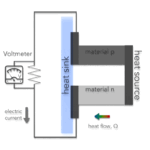A Peltier diode is a solid-state device that uses the Peltier effect to transfer heat, creating a temperature difference for cooling or heating applications.

Peltier Diode: Introduction and Applications
A Peltier diode, also known as a thermoelectric cooler (TEC), is a solid-state device that exploits the Peltier effect to create a temperature difference between its two sides by transferring heat from one side to the other using electrical energy. The Peltier effect, named after the French physicist Jean Charles Athanase Peltier, is the direct conversion of electrical energy into a temperature difference in a conductive material. Peltier diodes have gained popularity in recent years due to their compact size, reliability, and lack of moving parts, which make them ideal for a variety of cooling and heating applications.
Working Principle
Peltier diodes consist of two dissimilar semiconductor materials, typically n-type and p-type bismuth telluride, connected electrically in series and thermally in parallel. When a direct current (DC) is applied to the diode, the electrons in the n-type material move towards the positive terminal, absorbing heat and cooling the junction. Simultaneously, the holes in the p-type material move towards the negative terminal, releasing heat and warming the junction. This causes a temperature difference across the device, with one side becoming hot and the other cold.
Key Components
There are three key components in a Peltier diode that contribute to its performance:
- Thermoelectric materials: The choice of materials directly impacts the efficiency and temperature differential achievable by the device. Commonly used materials include bismuth telluride, lead telluride, and silicon germanium.
- Thermoelectric couples: These are the building blocks of the Peltier diode, consisting of two thermoelectric materials connected by a metallic bridge. The number of couples in a device determines its cooling capacity and voltage requirements.
- Ceramic plates: These plates are used to sandwich the thermoelectric couples, providing electrical insulation and efficient heat transfer between the device and the heat source or sink.
Applications
Peltier diodes are used in various applications, including:
- Cooling and temperature control: Peltier diodes are commonly used for cooling electronic components, such as CPUs, lasers, and imaging sensors, as well as temperature control in scientific instruments, medical equipment, and consumer products like mini-refrigerators and portable coolers.
- Thermal cycling: They are also utilized in thermal cycling applications, such as polymerase chain reaction (PCR) machines, where precise temperature control is essential for the amplification of DNA samples.
- Energy harvesting: By reversing the Peltier effect, these devices can be used as thermoelectric generators (TEGs) to convert waste heat into electrical energy, providing a sustainable power source for remote or low-power applications.
Advantages and Disadvantages
There are several advantages and disadvantages associated with Peltier diodes:
Advantages
- Solid-state design: Peltier diodes have no moving parts, which results in low maintenance, high reliability, and a long operational life.
- Compact size: These devices are small and lightweight, making them suitable for integration into a wide range of applications.
- Precise temperature control: Peltier diodes provide precise and rapid temperature control, enabling their use in sensitive applications.
- Reversible operation: By reversing the polarity of the applied voltage, Peltier diodes can switch between heating and cooling, offering flexibility in their usage.
Disadvantages
- Low efficiency: Peltier diodes generally have a lower efficiency compared to other cooling methods, such as vapor-compression refrigeration. This can result in higher energy consumption for the same cooling capacity.
- Heat dissipation: The hot side of the Peltier diode must be effectively cooled to maintain optimal performance. This often requires additional components, such as heat sinks and fans, which can increase the complexity and cost of the overall system.
- Cost: High-quality thermoelectric materials and manufacturing processes can make Peltier diodes more expensive than alternative cooling solutions.
Future Developments
There is ongoing research aimed at improving the efficiency and performance of Peltier diodes, focusing on the development of new thermoelectric materials and device designs. Some potential advancements include:
- Nanostructured materials: The use of nanostructured thermoelectric materials has shown promise in enhancing the performance of Peltier diodes by increasing their thermoelectric efficiency and reducing thermal conductivity.
- Flexible devices: Researchers are exploring the development of flexible and wearable Peltier diodes, which could be integrated into clothing or other wearable items for personal thermal management.
- Multi-stage cooling: Multi-stage Peltier devices can achieve larger temperature differences by stacking multiple diodes on top of each other, potentially expanding their applicability to more demanding cooling applications.
Conclusion
Peltier diodes, with their solid-state design and ability to precisely control temperature, have found a wide range of applications in various industries. While they have certain limitations, such as low efficiency and the need for effective heat dissipation, ongoing research in thermoelectric materials and device designs holds promise for overcoming these challenges and expanding the potential uses of Peltier diodes in the future.



